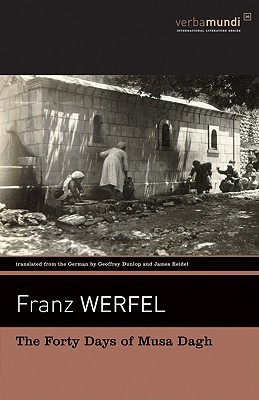A tiny island in the Golf of Naples, the buzzing Chinese capital Beijing, London and a legendary mountain watching over six Anatolian villages and the Syrian coast were the scenes of the books that I reviewed here three years ago. My tour started with the Italian classic Arturo’s Island by Elsa Morante containing the (fictitious) memoirs of a childhood and youth before World War II. Then I hurried after the young man from the contemporary Chinese novel Running Through Beijing by Xu Zechen who set his hopes on life in the metropolis. My trip to the British capital in the 1980s brought me into touch with The Good Terrorist by en-NOBEL-ed Doris Lessing who dreamed of changing the world. And finally, the Austrian classic The Forty Days of Musa Dagh by Franz Werfel made me share the lives of Eastern Anatolian villagers who refused to surrender to the Ottoman army sent out to drive them away from home in 1915.
- - - - -
 In Arturo’s Island, first published in 1957, Italian writer Elsa Morante evokes a man’s solitary and free childhood on the island of Procida in the Golf of Naples from the late 1920s through the dawn of World War II. The motherless boy adores his half-German father like a God although he is restless and travels a lot dropping by only occasionally. In the care of a servant the protagonist grows up without cares and worries. He passes his time roaming the island, sailing his boat and reading whatever book gets into his hand. With their house – a former monastery – a little off the village, the servant and his dog are his primary company. Things change for him when he is fourteen years old and his father suddenly arrives from Naples with a sixteen-year-old wife in tow.
In Arturo’s Island, first published in 1957, Italian writer Elsa Morante evokes a man’s solitary and free childhood on the island of Procida in the Golf of Naples from the late 1920s through the dawn of World War II. The motherless boy adores his half-German father like a God although he is restless and travels a lot dropping by only occasionally. In the care of a servant the protagonist grows up without cares and worries. He passes his time roaming the island, sailing his boat and reading whatever book gets into his hand. With their house – a former monastery – a little off the village, the servant and his dog are his primary company. Things change for him when he is fourteen years old and his father suddenly arrives from Naples with a sixteen-year-old wife in tow.
- - - - -
The protagonist of much praised Chinese author Xu Zechen is constantly Running Through Beijing in the attempt to make his living or even better his fortune. He is a young man from the countryside who – like many others – left home and family not seeing any perspective for a worthwhile future there and he went to Beijing, the capital of China and at the same time bustling economic centre, to profit from booming business and to enjoy all the amenities of modern city life. But he soon learns that even in Beijing it is very hard to shake off misery. Before long the necessity to feed himself drives him to commit petty crimes… and like for many other young immigrants from the rural areas this is the beginning of a slide straight into the vicious circle of crime.
»»» Read my review
- - - - -
 The Good Terrorist by Doris Lessing, winner of the Nobel Prize in Literature 2007, is a woman in her mid-thirties with a middle-class background and a university degree, but she has committed herself to the Communist cause and to the man she loves although he is homosexual. In the early 1980s, they live together with other comrades in a commune of squatters dedicating their time and limited resources to all kinds of activities to protest against capitalist society in general and the political establishment in particular. When they realise that authorities and bourgeois society don’t take them seriously, even ignore them, they decide to go a step further. They get in touch with the KGB and with the IRA, but they don’t want them, either. So they decide to take action.
The Good Terrorist by Doris Lessing, winner of the Nobel Prize in Literature 2007, is a woman in her mid-thirties with a middle-class background and a university degree, but she has committed herself to the Communist cause and to the man she loves although he is homosexual. In the early 1980s, they live together with other comrades in a commune of squatters dedicating their time and limited resources to all kinds of activities to protest against capitalist society in general and the political establishment in particular. When they realise that authorities and bourgeois society don’t take them seriously, even ignore them, they decide to go a step further. They get in touch with the KGB and with the IRA, but they don’t want them, either. So they decide to take action.»»» Read my review
- - - - -
 Inspired by the misery in Armenian refugee camps that Franz Werfel had seen during his travels of the Middle-East in the early 1930s, he wrote The Forty Days of Musa Dagh as a fictional account of a true story. In April 1915, the Ottoman rulers launch their big stroke against the hated Christian-Armenian population in Eastern Anatolia that has the same effect as genocide without being one in the strict sense. Unwilling to let themselves be forcibly “relocated” to the Syrian Desert, the inhabitants of six Armenian villages offer fierce resistance on the Musa Dagh – Mount Moses – at the Syrian coast during the summer of 1915. Although Ottoman forces are by large superior in number and better equipped almost all Armenian villagers survive until French and British warships rescue them virtually in the last minute.
Inspired by the misery in Armenian refugee camps that Franz Werfel had seen during his travels of the Middle-East in the early 1930s, he wrote The Forty Days of Musa Dagh as a fictional account of a true story. In April 1915, the Ottoman rulers launch their big stroke against the hated Christian-Armenian population in Eastern Anatolia that has the same effect as genocide without being one in the strict sense. Unwilling to let themselves be forcibly “relocated” to the Syrian Desert, the inhabitants of six Armenian villages offer fierce resistance on the Musa Dagh – Mount Moses – at the Syrian coast during the summer of 1915. Although Ottoman forces are by large superior in number and better equipped almost all Armenian villagers survive until French and British warships rescue them virtually in the last minute.»»» Read my review

No comments:
Post a Comment
Dear anonymous spammers: Don't waste your time here! Your comments will be deleted at once without being read.